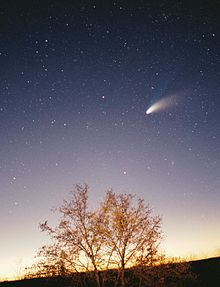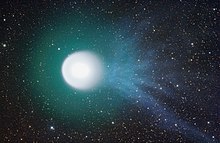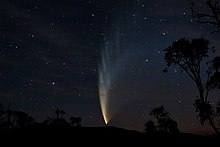
A comet is a relatively small, rocky, and icy mass in the Solar System, usually larger than a meteoroid, that, when it is close enough to the Sun, displays a visible coma (a thin, fuzzy, temporary atmosphere), and sometimes also a tail, both because of the effects of solar radiation and the solar wind upon the nucleus of the comet. Comet nuclei are loose collections of ice, dust, and small rocky particles, ranging from a few hundred meters to tens of kilometers across. Comets have been observed since ancient times and have historically been considered bad omens. The number visible to the naked eye averages to roughly one per year, though many of these are faint and unspectacular. Particularly bright or notable examples are called "Great Comets".
Comets have a wide range of different orbital periods, ranging from just a few years to hundreds of thousands of years. Some rare hyperbolic comets have been found by calculations in celestial mechanics to pass only once through the inner Solar System before being thrown out into interstellar space along hyperbolic trajectories.
Short-period comets have been found to originate in the Kuiper Belt, or its associated scattered disc, which lie beyond the orbit of Neptune. Longer-period comets are thought to have their origins much further away in the Oort Cloud, a cloud of icy bodies at the outer boundaries of the Solar System that were left behind during the condensation of the solar nebula. Long-period comets plunge towards the Sun from the Oort Cloud because of gravitational perturbations caused by either the massive outer planets of the Solar System (Jupiter, Saturn, Uranus, and Neptune), or passing stars.
Comets are distinguished from asteroids by the presence of a coma and/or a tail. However, ancient comets that have passed close to the Sun many times have lost nearly all of their volatile ices and dust, and may come to resemble small asteroids (see Extinct comets). Asteroids are thought to have a different origin from comets, having formed in the inner Solar System (inside the orbit of Jupiter) rather than in the outer Solar System, but recent findings have somewhat blurred the distinction between asteroids and comets (see centaurs and asteroid terminology).
As of May 2009[update] there are a reported 3,648 known comets of which about 1,500 are Kreutz Sungrazers and about 400 are short-period. This number is steadily increasing. However, this represents only a tiny fraction of the total potential comet population: the reservoir of comet-like bodies in the outer solar system may number one trillion.
Comet Holmes (17P/Holmes) in 2007 showing blue ion tail on right
 The Great Comet of 1882, is a member of the Kreutz group
The Great Comet of 1882, is a member of the Kreutz group
No comments:
Post a Comment